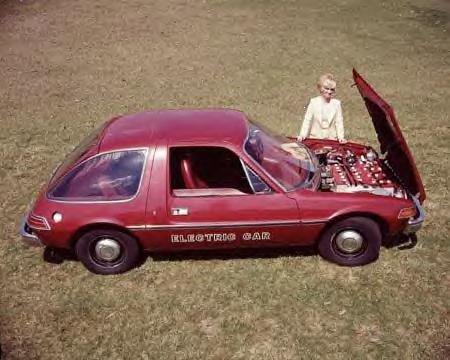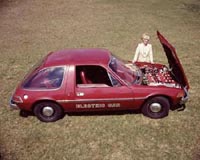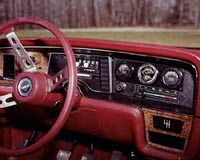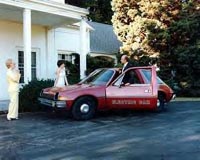 |
ABOUT THE SITE | CONTACT |
| History & Stats |
| Classifieds |
| Technical Info |
| Famous Pacers |
| Pacer Stories |
| Photos & Images |
| Collectibles |
| Multimedia |
| Resources |
The Electric Pacer
Dennis Eichenberg had the privilege to work on converting Pacers and other cars to electric power throughout his career as an electrical engineer. Dennis shares the story of The Electric Pacer below.

This is the story of the Electric Pacer! The energy crisis of the early 1970's generated great interest in electric vehicles, to reduce U.S. dependency upon fossil fuels. The U.S. Department of Energy initiated several electric vehicle programs to spur development. Fleet users were encouraged to utilize electric vehicles as much as possible. Out of this environment, Electric Vehicle Associates (EVA), Incorporated and the Change of Pace Electric Pacer came to be!
High school vocational education teachers in Cleveland, Ohio as a student project started EVA. EVA had converted various vehicles to electric power, but when the Pacer hit the scene, it made the ideal electric vehicle. The Pacer was strong, large on the inside, and small on the outside (for the 1970's). The large interior volume was ideal for carrying the lead acid batteries, battery charger, and motor controller that was required for the vehicle. The Change of Pace was a stellar performer. Top speed was in excess of 55 mph, 0 to 30 mph was achieved in less than 12 seconds, and the range was 30 to 50 miles, per SAE J227A schedules.
At first EVA purchased the Pacer as a complete vehicle. The engine, fuel tank, and other components not required for the electric vehicle were removed, and then the electric components were installed. As fleet orders for the vehicle were received, EVA purchased the Pacer from AMC without the gasoline components, and EVA installed the electric components.
The Pacer was not modified externally by EVA. The electric components added weight to the Pacer, bringing the curb weight up to 4150 pounds. Modification of the suspension was required to accommodate the additional weight. The instrument panel was supplemented with a voltmeter and an ammeter to assist the driver. The electric motor was a 15 KW unit with forced air ventilation. The motor controller was an electronic SCR unit. The energy came from twenty deep discharge lead acid 6-volt batteries connected in series to provide a 120-volt traction system. The battery charger was installed on board and could be powered from 110-volt or 220-volt ac power systems. A transmission was used, and either a manual or automatic ransmission was available. Front disc brakes were provided. DR78x14 steel belted radial tires were installed to accommodate the additional weight of the batteries. A 10,000 BTU gasoline heater was provided. Most Pacer accessories were available, including air conditioning and stereo radios.
The various Pacer models were converted, but the station wagon was the most popular conversion for fleet use. Many individuals purchased the Change of Pace, and these could be very exciting automobiles, especially when cost was not an issue. Some of these cars had every option available, and they were really very nice automobiles.
The Change of Pace was driven the same as a gasoline powered Pacer, and the operation was invisible to most drivers. The car was completely silent when stopped, which is a very unusual experience. It seems that the car has stalled, but it is ready to go whenever the accelerator is depressed. Electric vehicles produce maximum torque at start, so they feel very energetic. The additional weight and modified suspension produced a very smooth ride.
The batteries required significant maintenance. The batteries had to be fully recharged after every use, or would be damaged. Recharging required several hours, depending upon how much the batteries were discharged. The batteries had to have water added every few weeks, depending upon use. The batteries posed the biggest problem for the Change of Pace. EVA stopped production of the Change of Pace, when the Pacer was no longer available from AMC, and EVA went out of business shortly thereafter.
EVA made well over 100 Change of Pace Pacers, and then turned to Ford Fairmonts and Ford Escorts after the Pacer (they didn't have nearly the character that the Pacer had). Long Island Light in New York was the largest fleet purchaser of the Change of Pace Pacer.
Following are some photos of the Change of Pace. These were truly great times!



Click on the thumbnail to view the full-sized image.
A Change of Pace (YouTube): Liquid Logic Films chronicles the story of the rise and fall of the Electric Pacer.
ABOUT THE SITE | CONTACT
© 1995-2025 panhorst.net, L.L.C.